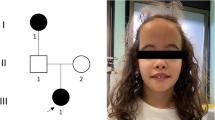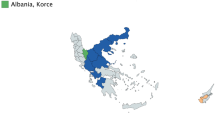Abstract
Uniparental disomy (UPD) 15, detected in patients with Prader–Willi (PWS) and Angelman syndromes, has to date always involved the entire chromosome 15. We report the first case of segmental maternal uniparental heterodisomy confined to a proximal part of chromosome 15 in a child with clinical features of PWS. This unusual finding can be explained by the rare combination of three consecutive events: a trisomy 15 zygote caused by a maternal meiosis I error, early postzygotic mitotic recombination between maternal and paternal chromatids, and, finally, trisomy rescue by the loss of the rearranged chromosome 15 containing the paternal 15q11–q13 segment.
Similar content being viewed by others
Introduction
Among more than 100 cases of UPD for different chromosomes reported in the literature to date, the overwhelming majority shows UPD for an entire chromosome. However, UPD of segments of chromosomes with the exception of mosaicism for paternal UPD of the chromosomal segment 11p15-pter in patients with Beckwith–Wiedemann syndrome (BWS) have only occasionally been reported.1 Although maternal UPD(15) is not an infrequent finding, occurring in approximately 30% of patients with Prader–Willi syndrome (PWS), and paternal UPD(15) is found in about 5% of cases with Angelman syndrome (AS), no case with UPD of only a segment including the critical region 15q11.2–q12 has so far been reported. This prompts us to describe the observation of segmental heterodisomic maternal UPD15 in a patient with PWS.
Case report
The propositus, a male (Figure 1), was the first-born child of healthy, non-consanguineous parents. At the time of delivery, the mother was 22 years and the father 24 years old. The mother reported diminished fetal activity. The patient was born after a term uncomplicated pregnancy and induced delivery at 40 weeks. Birth weight was 3200 g (25th centile), and length was 53 cm (90th centile). His father's height is 176 cm and his mother's is 180 cm. The infant had severe hypotonia and poor suck in the neonatal period. After the age of 6 months feeding difficulties improved, and he developed progressive obesity: at 9 months of age his weight was 10.0 kg (75th centile), and at 1 year – 12.4 kg (95th centile). He was referred to the Tomsk Institute of Medical Genetics at the age of 2 years for genetic evaluation with a preliminary diagnosis of PWS.
At examination at 2 years of age, the proband had severe obesity resulting from hyperphagia, convergent strabismus, full cheeks, microstomia with carp-shaped mouth, short neck, small hands with delicate and tapering fingers, and small feet (foot length 11.6 cm, <3rd percentile). He also had cryptorchidism with hypoplastic penis and scrotum, muscular hypotonia, hyporeflexia, retarded psychomotor, and speech development. His weight was 20.7 kg (far above the 97th centile), and his length was 87 cm (50th centile). The phenotype is consistent with the diagnosis of PWS.
Methods
Peripheral blood samples were collected from the patient and both of his parents for cytogenetic and molecular analysis. Peripheral blood lymphocytes were cultured according to standard techniques, followed by staining with GTG and DA-DAPI. Fluorescence in situ hybridization (FISH) was performed according to the manufacturers’ protocols using the commercially obtained locus-specific DNA probes SNRPN/PML and D15S10/PML (Appligene and Oncor).
The analysis of methylation status of the SNRPN gene, in the PWS critical region 15q11–q13, was done by methylation-specific PCR using DNA treated with sodium bisulfite.2 Genomic DNA was purified using a commercial kit (Promega, Madison, WI, USA) and microsatellite analysis was performed according to standard protocols.
Results and discussion
Conventional chromosome analysis following GTG banding showed a normal male karyotype with 46 chromosomes in all 50 cells examined. The FISH results with the two DNA probes SNRPN/PML and D15S10/PML confirmed the lack of a deletion at 15q11–q13. A single band representing methylated SNRPN alleles, that is, the maternal alleles in the normal situation, was observed by methylation-specific PCR technique with DNA treated with sodium bisulfite (data not shown). This pattern is typically detected in PWS patients. The analysis of 19 polymorphic microsatellite markers distributed along chromosome 15 showed five fully informative markers mapping to 15q11–12.2 with two different maternal alleles and no paternal allele in the patient, indicating maternal uniparental heterodisomy of chromosome 15 (Figure 2, Table 1). However, five more distally located informative markers demonstrated biparental inheritance (Figure 2, Table 1). A maternal uniparental disomy could be excluded for the partially informative markers D15S1048 and D15S144. Thus, the uniparental disomy appears to extend to a position between 24.2 (15q12.2) and 27.4 Mb (15q13.3). Paternity was confirmed with high probability (at least 99.9%) by the results of the analysis of seven microsatellite markers mapping to other chromosomes (data not shown).
Microsatellite markers indicating matUPD15 at the proximal and biparental inheritance at the distal part of the long arm of chromosome 15. (a–d) matUPD15 of the 15q11–q13 region revealed by markers D15S817 (a), D15S1234 (b), D15S128 (c), and D15S172 (d). (e–g) Biparental inheritance at markers D15S643 (e), D15S642 (f), and D15S123 (g). F – father; P – proband; M – mother; L – ladder.
To the best of our knowledge, only 13 cases of segmental UPD have been reported to date. These consisted of: one case with unclear parental origin of isodisomy for chromosome 4p;3 eight cases with segmental maternal UPD (for chromosomes 2, 4, 7, 14, 17, and X),4,5,6,7,8,9,10,11 and four cases with segmental paternal UPD (for chromosomes 6, 14, and 20).12,13,14,15 Cases of segmental heterodisomy are rarer than cases with isodisomy: only three cases of heterodisomy have been detected (for chromosomes 14 and 17)8,9,10 and all of them were maternal in origin. However, at a recent re-evaluation of one case previously reported as having segmental matUPD14,8 the results of comprehensive microsatellite marker analysis did not confirm maternal UPD.16
Maternal heterodisomy 15 in our proband with PWS was observed at 15q11.1–12.2 (the most distal informative marker was GABRB3), while analysis of markers mapping to more distal segments of the long arm of chromosome 15 demonstrated biparental inheritance. The relative proneness to recombinations of the 15q11–q13 region may be attributed to low copy repeats derived from large genomic duplications in the vicinity of the common breakpoints.17 The mechanism of formation of segmental maternal UPD in our case appears to be the combination of three consecutive events: trisomy 15 in the zygote following a maternal meiosis I error, early postzygotic mitotic recombination between maternal and paternal chromatids, and, finally, trisomy rescue by loss of the rearranged homologue containing the paternal 15q11–q13 segment. Although a similar case has not, to the best of our knowledge, been reported to date, it has to be emphasized that such an event could easily be overlooked if the analysis, aimed at detecting a maternal UPD of the critical 15q11–q13 region, is not extended to more distal regions. Although it is highly advisable to test distal markers, informative markers at 15q11–13 that show heterodisomy would be per se sufficient for a molecular diagnosis (if the methylation test is also abnormal and paternity is confirmed).
Finally, the observation that our proband's phenotype was in no way different from patients with maternal UPD for the entire chromosome 15 confirms the assumption that maternal UPD of the segments beyond 15q11–q13 has no additional influence on the phenotype.
References
Kotzot D : Complex and segmental uniparental disomy (UPD): review and lessons from rare chromosomal complements. J Med Genet 2001; 38: 497–507.
Kubota T, Das S, Christian SL, Baylin SB, Herman JG, Ledbetter DH : Methylation specific PCR simplifies imprinting analysis. Nat Genet 1997; 16: 16–17.
Collier DA, Barrett T, Curtis D, Macleod A, Bundey S : DIDMOAD syndrome: confirmation of linkage to chromosome 4p, evidence for locus heterogeneity and a patient with uniparental isodisomy for chromosome 4p. Am J Hum Genet Suppl 1995; 57: 1084.
Stratakis C, Taymans SE, Schteingart D, Haddad BR : Segmental uniparental isodisomy (UPD) for 2p16 without clinical symptoms: implications for UPD and other genetic studies of chromosome 2. J Med Genet 2001; 38: 106–109.
Tompson SW, Ruiz-Perez VL, Wright MJ, Goodship JA : Ellis–van Creveld syndrome resulting from segmental uniparental disomy of chromosome 4. J Med Genet 2001; 38: e18.
Yang XP, Inazu A, Yagi K, Kajinami K, Koizumi J, Mabuchi H : Abetalipoproteinemia caused by maternal isodisomy of chromosome 4q containing an intron 9 splice acceptor mutation in the microsomal triglyceride transfer protein gene. Arterioscler Thromb Vasc Biol 1999; 19: 1950–1955.
Hannula K, Lipsanen-Nyman M, Kontiokari T, Kere J : A narrow segment of maternal uniparental disomy of chromosome 7q31-qter in Silver–Russell syndrome delimits a candidate gene region. Am J Hum Genet 2001; 68: 247–253.
Martin RA, Sabol DW, Rogan PK : Maternal uniparental disomy of chromosome 14 confined to an interstitial segment (14q23–14q24.2). J Med Genet 1999; 36: 633–636.
Eggermann T, Mergenthaler S, Eggermann K et al: Identification of interstitial maternal uniparental disomy (UPD)(14) and complete maternal UPD(20) in a cohort of growth retarded patients. J Med Genet 2001; 38: 86–89.
Rio M, Ozilou C, Cormier-Daire V et al: Partial maternal heterodisomy of chromosome 17q25 in a case of severe mental retardation. Hum Genet 2001; 108: 511–515.
Avivi L, Korenstein A, Braier-Goldstein O, Goldman B, Ravia Y : Uniparental disomy of sex chromosomes in man. Am J Hum Genet 1992; 51 (Suppl): 33.
Lopez-Gutierrez AU, Riba L, Ordonez-Sanchez ML, Ramirez-Jimenez, Cerrillo-Hinojosa M, Tusie-Luna MT : Uniparental disomy for chromosome 6 results in steroid 21-hydroxylase deficiency: evidence of different genetic mechanisms involved in the production of the disease. J Med Genet 1998; 35: 1014–1019.
Das S, Lese CM, Song M et al: Partial paternal uniparental disomy of chromosome 6 in an infant with neonatal diabetes, macroglossia, and craniofacial abnormalities. Am J Hum Genet 2000; 67: 1586–1591.
Coveler KJ, Yang SP, Sutton R et al: A case of segmental paternal isodisomy of chromosome 14. Hum Genet 2002; 110: 251–256.
Bastepe M, Lane AH, Jüppner H : Paternal uniparental isodisomy of chromosome 20q – and the resulting changes in GNAS1 methylation – as a plausible cause of pseudohypoparathyroidism. Am J Hum Genet 2001; 68: 1283–1289.
Coveler KJ, Sutton VR, Knox-Dubois C, Shaffer LG : Comprehensive microsatellite marker analysis contradicts previous report of segmental maternal heterodisomy of chromosome 14. J Med Genet 2003; 40: e26.
Christian SL, Fantes JA, Mewborn SK, Huang B, Ledbetter DH : Large genomic duplicons map to sites of instability in the Prader–Willi/Angelman syndrome chromosome region (15q11–q13). Hum Mol Genet 1999; 8: 1025–1037.
Acknowledgements
This study was supported by the Swiss National Fund (Grant SNF 7IP65679)
Author information
Authors and Affiliations
Corresponding author
Rights and permissions
About this article
Cite this article
Nazarenko, S., Sazhenova, E., Baumer, A. et al. Segmental maternal heterodisomy of the proximal part of chromosome 15 in an infant with Prader–Willi syndrome. Eur J Hum Genet 12, 411–414 (2004). https://doi.org/10.1038/sj.ejhg.5201168
Received:
Revised:
Accepted:
Published:
Issue Date:
DOI: https://doi.org/10.1038/sj.ejhg.5201168
Keywords
This article is cited by
-
Update of the EMQN/ACGS best practice guidelines for molecular analysis of Prader-Willi and Angelman syndromes
European Journal of Human Genetics (2019)
-
Clinical and genetic characterization of Portuguese patients with pseudohypoparathyroidism type Ib
Endocrine (2010)
-
Characterization of an Autism-Associated Segmental Maternal Heterodisomy of the Chromosome 15q11–13 Region
Journal of Autism and Developmental Disorders (2007)
-
A fascination with chromosome rescue in uniparental disomy: Mendelian recessive outlaws and imprinting copyrights infringements
European Journal of Human Genetics (2006)





